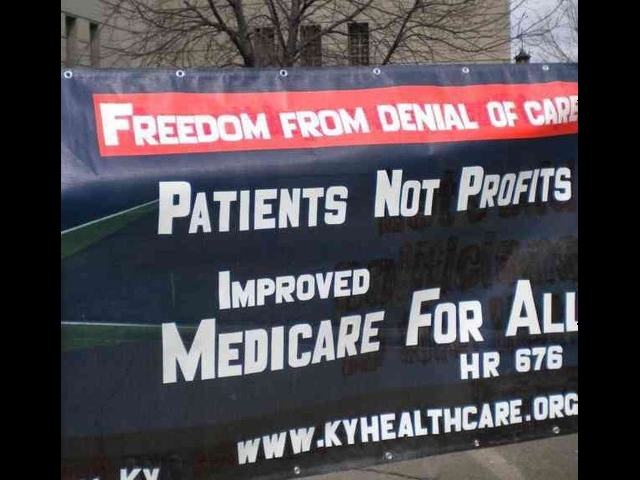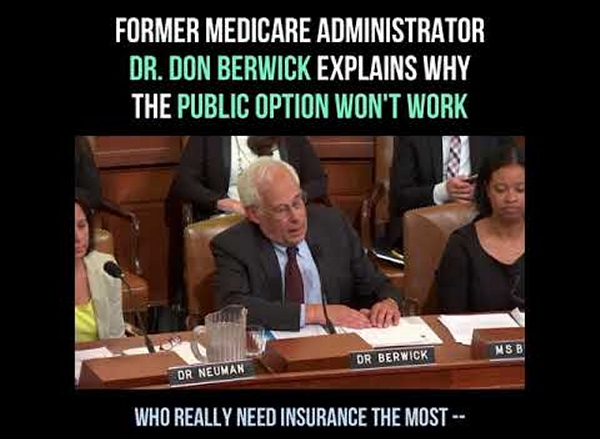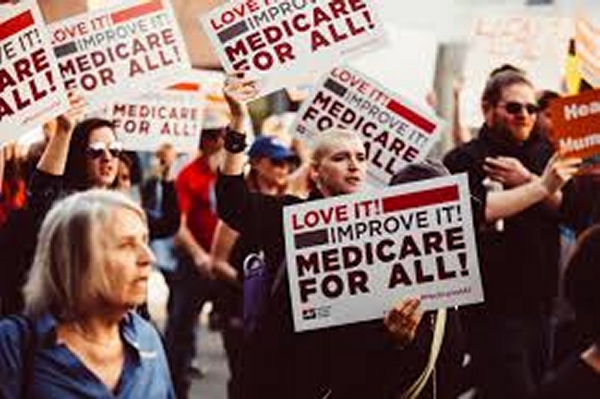
The champagne corks were popping in the offices of long-time advocates of a single payer health insurance system. All the hoopla because the second largest medical society in the U.S., the American College of Physicians with a membership of 159,000 internists issued a report “Envisioning a Better U.S. Health Care System for All: A Call to Action by the American College of Physicians,” which, at first glance, appears to support the creation of a single payer healthcare system. Reading the actual reports quickly bursts that bubble.
Instead Americans are offered the same old half-baked excuses to continue a privatized free-market insurance system. The carrot being a vague “transitioning” to universal coverage through either a “single payer system, or a public option to be offered along with regulated private insurance”
“Along with regulated private insurance.” The U.S. has had “regulated” private insurance since 2011. It’s called Obamacare. How well has that worked out? Even ACP has to admit that “[U.S. healthcare] costs too much; leaves too many behind … creates incentives misaligned with patients’ interests… spending too much on administration at the expense of patient care, and fosters barriers to care for and discrimination against vulnerable individuals.” Confronting these problems what kind of alchemy would be required to equate the effectiveness of a single payer insurance system with just another insurance plan, the public option, on the private market?
Bear in mind that The American College of Physicians has always played second fiddle to the larger, more prestigious American Medical Association. An organization of internists (aka primary care physicians) they only haul in between 5-10% of the money spent on healthcare nationally, a far cry from the 14% enjoyed by internists in other developed countries. According to their report, that inequity in pay scales must be addressed —“where primary care is supported with a greater investment of resources and… payment systems support the value that internal medicine specialists offer to patients…” Translation: primary care docs want seats on the healthcare gravy train. Not hard to see why. Their average salary of $218,000 pales in comparison to the average specialist salary of $318,000. That’s the major inequity these internists seem to be up in arms about.

Nowhere in all the envisioning ACP does in the pages of this weighty tome do they envision a national healthcare system that eliminates private insurance companies, says goodbye to fee-for-service, unaffordable deductibles, rising premiums and costly copays. Instead they come up with ten “aspirations” presented as solutions to the current catastrophic health care system. It won’t surprise you to learn that eight of the ten aspirations call for continued commodification of healthcare services with words ripped from private insurance manuals— “costs,” “payments and charges,” “financial incentives“ and “funding and resources.”
What even this milk-toast critique of the current healthcare system cannot hide is its basic inequality. More than14% of Americans cannot afford a bare-bones plan. Millions more buy low-priced insurance policies with walloping deductibles (as much as $10,000) that are virtually unusable. (2019 Gallup National Health and Well-being Index).
In the privatized U.S. insurance system, there is virtually no return on an investment of trillions. U.S. mortality rates for the leading causes of death are the highest among the world’s wealthy nations. Life expectancy rates have been declining for three straight years (with one-tenth of a year uptick in 2018). Yet U.S. leaders keep touting the U.S. healthcare system as the best In the world. It’s not even close to the best but it is the costliest. The U.S. is spending trillions on healthcare — in 2018, $3.65 trillion. Worse only two-thirds of the $3.65 trillion is spent on patient care. One trillion, or 30¢ of every $1.00 is siphoned off to pay “administrative costs,” doled out to insurance companies, doctors, hospitals, and drug companies.
Former Medicare administrator Dan Berwick speaking before the House Ways and Means Committee on June 12, 2019, explained why a public option would actually be good for private insurance companies and bad for poorer, sicker patients — “Insurance companies want to provide insurance to people who don’t need it. That’s how they make money… Insurance companies would try to find ways to have people who really need care go to the public option. It would be a good business case for them and that’s not good for the country.”

All a public option will do is add another insurance plan to the gaggle of private insurance plans already in operation. The public option will leave intact the two tiers of private healthcare—rich patients will still have unlimited choice of doctors, hospitals, procedures and drugs but pay more and more as the insurance companies pass on escalating reimbursement costs and poor, sicker people herded into a public option will be forced into narrow networks of doctors and hospitals willing to accept meager reimbursements.
Study after study, poll after poll, survey after survey have concluded that the public option hasn’t a prayer of making healthcare less costly or more accessible. A major drawback — to remain viable and offset the costs of insuring the poorest and sickest, enrollees will still be burdened with deductibles, copays and premiums. A 2013 analysis by the CBO (Congressional Budget Office) found that a public option would be only 6-8% less costly than private insurance and would leave more than 25 million Americans uninsured.
Where is the liberal media in all this hubbub? Doing their usual job as stenographers for private interests. Take a look at how the mainstream media handled the ACP report. The New York Times and The Washington Post chose to go with the same misleading headline — “Major Doctors’ Group Calls for U.S. to Assure Coverage for All.” Common Dreams, an internet liberal media “truth teller,” was all in “In Historic Shift, Second Largest Physician’s Group in U.S. has New Prescription: It’s Medicare-For-All.” Modern Healthcare handled the news a little differently with a factual headllne — “American College of Physicians endorses single-payer, public option plans.” But quickly got down to the business of serving their masters in the first paragraph — “The second-largest physician group in the United States on Monday endorsed single-payer healthcare system reform to achieve universal insurance coverage.”
How about liberal guru Ezra Klein pompously informing us — “Democrats have embraced a politically powerful, but intentionally confusing, slogan to describe their health care goals… [Medicare-for-All] doesn’t mean what it sounds like it means.” Has a familiar ring. Remember John Kerry’s never-be-forgotten defense of his vote on funding the wars in Afghanistan and Iraq — “I actually did vote for the $87 billion, before I voted against it.”

Whether or not the ACP was trying to put one over on the public, the fact remains that a public option will never succeed in making healthcare accessible and affordable to all Americans. By upending the private interests that are robbing patients’ blind, a national single payer system will make it possible to offer the same degree of healthcare to every American rich or poor.
There are lots of wealthy and powerful enemies who will fight tooth and nail to convince Americans that single payer is “un-American” (Howard Schultz, Starbucks). Sometimes even billionaires overreach. Like Jeff Bezos, the richest man in the world, who just lit a fire under single payer advocates when he announced that he was eliminating company health insurance for 1,900 part-time employees at Whole Foods.
And when they ask (and they always do) where the money is coming from. Tell them it’s hiding in plain sight right next to the trillions that pay for U.S. misbegotten military adventures.
483 total views, 1 views today
